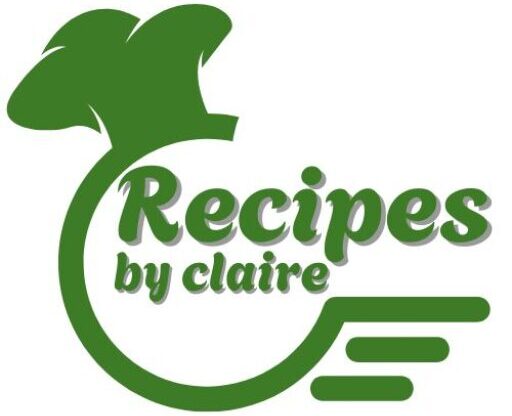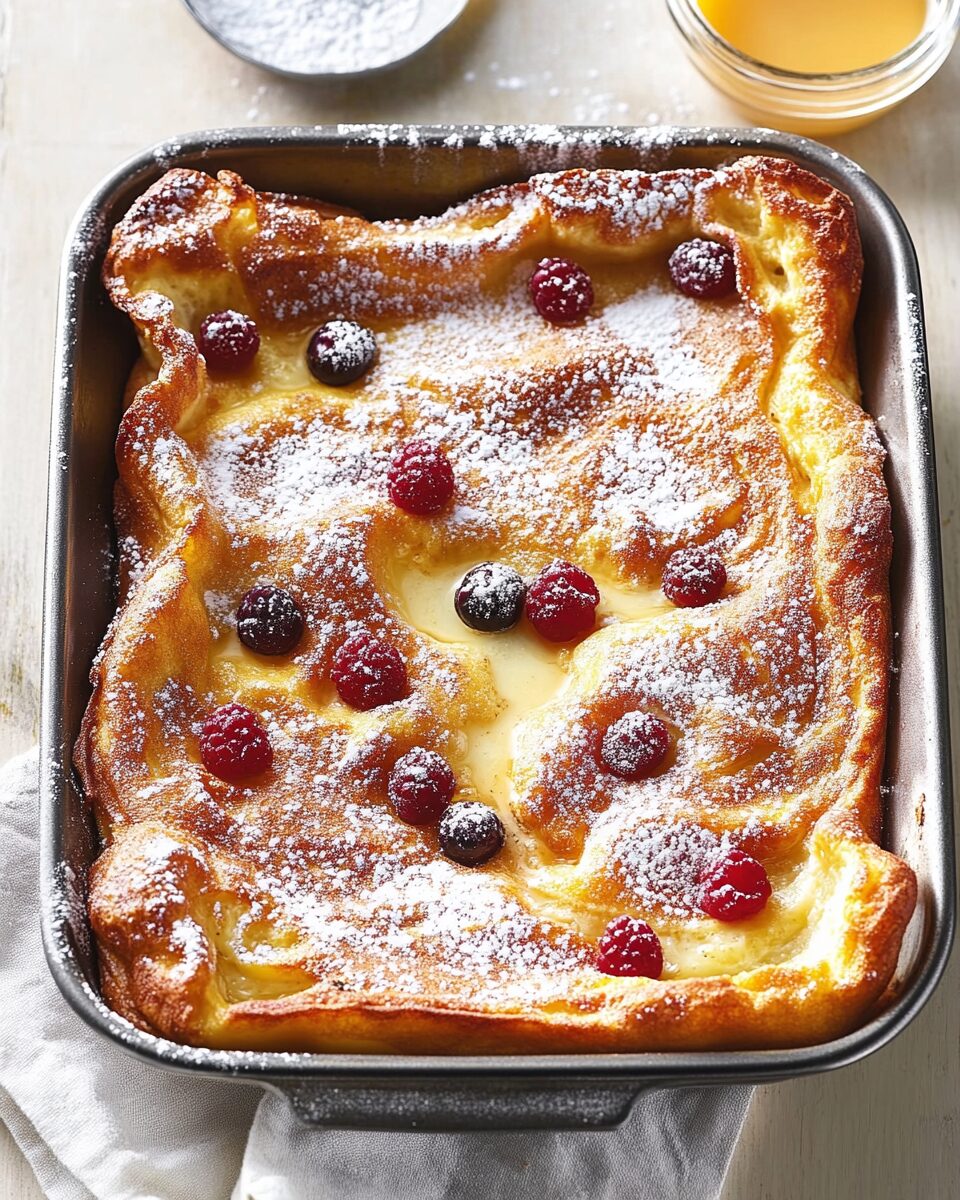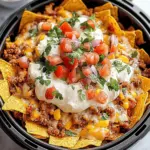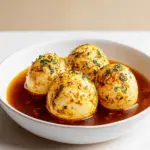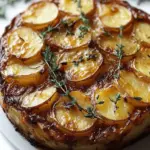The Puffy Oven-Baked German Pancake, also known as a Dutch Baby, is a brunch marvel that rises like magic in the oven. With its golden edges and soft, custardy center, it’s a showstopper that tastes just as amazing as it looks. A dusting of powdered sugar and a handful of juicy berries elevate this simple bake into an elegant dish worthy of any breakfast table. Best of all, it comes together in minutes with basic pantry ingredients. Whether you’re hosting a weekend brunch or just want to treat yourself, this airy delight delivers comfort, beauty, and flavor in every bite. It’s a classic you’ll come back to again and again.
Full Recipe:
Ingredients:
-
3 large eggs
-
2/3 cup all-purpose flour
-
2/3 cup milk
-
1 tablespoon granulated sugar
-
1/4 teaspoon salt
-
1/2 teaspoon vanilla extract
-
2 tablespoons unsalted butter
-
Powdered sugar, for topping
-
Fresh berries (strawberries, blueberries, raspberries), for serving
-
Maple syrup or honey, optional
Directions:
-
Preheat your oven to 425°F (220°C).
-
In a mixing bowl, whisk together the eggs, flour, milk, sugar, salt, and vanilla extract until smooth and well combined.
-
Place a 10-inch cast iron skillet or ovenproof baking dish in the oven with the butter. Allow the butter to melt completely, then carefully swirl the pan to coat the bottom and sides.
-
Quickly pour the batter into the hot skillet and return to the oven.
-
Bake for 20-25 minutes or until the pancake is puffed and golden brown.
-
Remove from the oven and let it cool slightly it will deflate naturally.
-
Dust with powdered sugar and top with fresh berries. Serve with maple syrup or honey if desired.
Prep Time: 10 minutes | Cooking Time: 25 minutes | Total Time: 35 minutes
Kcal: 230 kcal | Servings: 4 servings
The Magic of the Puffy Oven-Baked German Pancake: A Dutch Baby Delight
The Puffy Oven-Baked German Pancake, commonly known as a Dutch Baby, is a dish that beautifully balances simplicity with elegance. Rising dramatically in the oven and boasting crispy, golden edges and a soft, custard-like center, this pancake makes a bold and irresistible statement on any breakfast or brunch table. It has a rich history, requires minimal ingredients, and lends itself to a variety of flavor combinations, making it a versatile favorite among home cooks and food lovers alike.
A Brief History: German Roots, American Name
Despite the name, the “Dutch Baby” isn’t actually Dutch. The term is believed to have evolved from the word “Deutsch,” the German word for “German.” It is thought to have originated from German-American immigrants who brought their pancake traditions to the United States. Over time, the recipe gained popularity, particularly in the Pacific Northwest.
One of the earliest popularizations of the Dutch Baby in America was at Manca’s Café in Seattle in the early 1900s. There, the owner’s daughter supposedly coined the term “Dutch Baby,” and the rest is culinary history. Today, this pancake enjoys global appreciation, thanks to its simplicity, theater, and irresistible taste.
What Makes a Dutch Baby So Unique?
Unlike traditional stovetop pancakes, a Dutch Baby is baked in the oven, typically in a cast iron skillet. This method gives it a signature puffiness, as the steam created by the batter rising in a hot pan expands rapidly, pushing the edges upward. The pancake’s dramatic rise and fall make it an exciting experience almost like watching a soufflé in action.
There’s no leavening agent like baking soda or baking powder in the batter. The rise is purely the result of the eggs and the oven heat. The result is a beautiful puffed pancake with a light, airy center and crisp edges almost a hybrid between a pancake, a crepe, and a popover.
Nutritional Value and Versatility
Dutch Babies are surprisingly light and can be tailored to various dietary needs. The base ingredients eggs, milk, flour, and a touch of sugar make it protein-rich and satisfying. For those who are gluten-sensitive, gluten-free flours can be used without significantly compromising the texture. Similarly, dairy-free milks like almond, oat, or soy can be substituted for regular milk, and butter alternatives can be used for a vegan version.
Toppings can range from sweet to savory. Classic pairings include powdered sugar and lemon juice, fresh berries and whipped cream, or maple syrup and sliced bananas. On the savory side, think herbs, sautéed mushrooms, cheese, or even smoked salmon with crème fraîche.
Equipment and Preparation Tips
While you can technically use any ovenproof pan or dish, a cast iron skillet is the gold standard. Its excellent heat retention and distribution are key for achieving that signature puff. Preheating the skillet with butter before adding the batter is critical. This not only ensures that the batter starts cooking immediately (which aids the puffing) but also prevents sticking and adds rich flavor.
Blending the batter well preferably with a hand blender or stand mixer also contributes to a smoother, more consistent rise. A well-mixed batter allows for the even distribution of air, which results in a fluffier texture. Letting the batter rest for a few minutes before baking can also improve its texture.
Why It’s Perfect for Entertaining
Dutch Babies are the perfect centerpiece for a weekend brunch or family breakfast. They look impressive with minimal effort and are easy to serve just slice and plate. They’re also customizable, so everyone at the table can personalize their slice with the toppings of their choice.
If you’re hosting, the batter can be prepared in advance and stored in the fridge for up to a day. Just be sure to give it a good whisk before pouring it into the hot skillet. Serve it with a topping bar berries, syrups, honey, nuts, jams, or even a few savory options for a build-your-own Dutch Baby experience.
Pairing Ideas for the Ultimate Brunch
Want to go all-in for your next brunch gathering? Here are a few delicious pairing ideas to make your Dutch Baby meal complete:
-
Fresh Squeezed Orange Juice or Mimosas: The citrus notes enhance the pancake’s subtle vanilla flavor.
-
Crispy Bacon or Breakfast Sausage: A salty contrast to the sweet pancake that’s hard to beat.
-
Yogurt Parfaits: Add some granola and fruit for an elegant touch.
-
Coffee or Espresso: Complements the pancake’s slightly eggy, rich profile.
You can also serve your Dutch Baby alongside other brunch staples like fruit salad, roasted potatoes, or scrambled eggs for a more extensive spread.
Common Troubleshooting Tips
Like any baked dish, Dutch Babies can sometimes be a bit unpredictable. Here are a few common issues and how to solve them:
-
It didn’t puff up: This usually happens if the skillet wasn’t hot enough or if the oven wasn’t fully preheated. Always give your oven at least 10–15 minutes to reach the right temperature.
-
It deflated too quickly: It’s natural for the pancake to deflate after coming out of the oven, but a slow, steady decline indicates proper structure. To slow the collapse, let it rest in the oven (with the door ajar) for 1–2 minutes after baking.
-
It stuck to the pan: Properly preheating the skillet and using enough butter helps create a nonstick surface. Cast iron that’s not well-seasoned might cause sticking, so be sure your pan is in good condition.
Kids and Family Appeal
This pancake is often a hit with kids thanks to its fun, puffy appearance and sweet flavor. It’s a great way to get children involved in cooking, as the batter is simple to mix and the transformation in the oven is exciting to watch. You can even create individual Dutch Babies using mini skillets or muffin tins for a kid-friendly twist.
Storage and Reheating
Dutch Babies are best enjoyed fresh out of the oven, but if you do have leftovers, they store well. Keep them in an airtight container in the refrigerator for up to 2 days. To reheat, place them in a 300°F (150°C) oven for about 5–7 minutes or until warmed through. They can also be enjoyed cold, topped with yogurt and fruit like a soft breakfast tart.
Conclusion:
The Puffy Oven-Baked German Pancake is more than just a trendy brunch option it’s a dish with history, flair, and delicious versatility. Whether you’re looking for a quick weekday breakfast or a show-stopping brunch centerpiece, the Dutch Baby delivers. It’s easy enough for beginners but elegant enough to impress, making it a must-have in your breakfast recipe collection.
This recipe also serves as a foundation for creativity. Once you’ve mastered the basic technique, the variations are endless seasonal fruits, savory herbs, or global spice blends can all find a home in or on your Dutch Baby. With a little practice and a few pantry staples, you’ll be baking up golden, puffy pancakes that delight everyone at the table.
